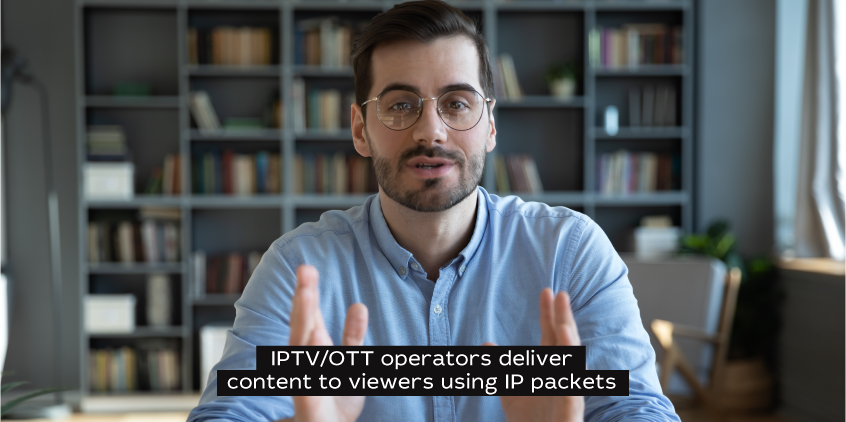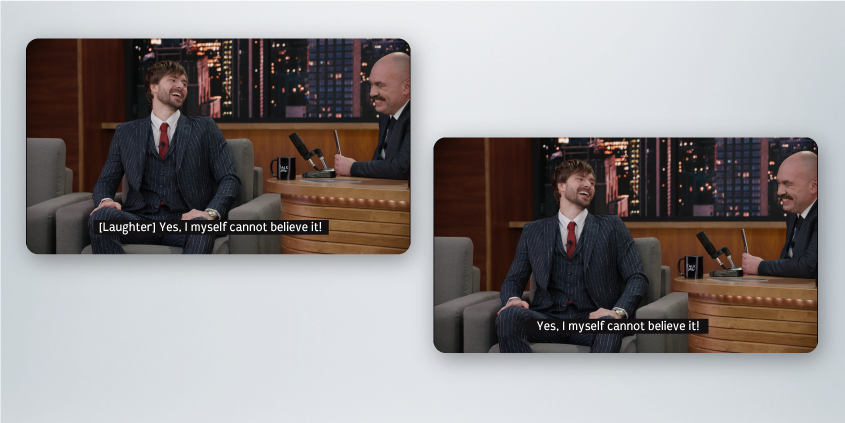Product request
You are looking for a solution:
Select an option, and we will develop the best offer
for you
Captioning types and why viewers need them
Captions are text that accompanies a video sequence and may include:
- Speech in a video
- Speech translation
- Description of ambient sounds (e.g., music, laughter, knocking, etc.)
- Comments (e.g., news context, sports competition score, explanation of terms, etc.)

Usually, the text is placed in one to three lines in the center of the screen. In some cases, the text is placed in other parts of the screen, e.g. to avoid overlapping a significant element of a video sequence.
Captioning is primarily intended for people with hearing impairment. According to the WHO, they constitute 5% of the world population, while by 2050, the percentage will be 10%. However, according to the research by the BBC, around 10% of viewers regularly turn on captions, while 35% of the audience watch children’s content using captions.
Captions help ordinary viewers watch movies and TV shows with the original voice-over, learn foreign languages, or be quiet when they cannot turn on the sound, such as in a public place or to avoid bothering the family.
In fact, legislation in some countries directly obliges operators and channels to caption all or some of their programs. For example, such requirements exist in the US, Canada
In English – mostly in the US and Canada – the terms ‘subtitle’ (a foreign speech translation), and ‘caption’ (a text version of a speech and additional information for people with hearing impairment) have different meanings. Other languages use constructions to separate these terms.

Captions for people with hearing impairment | Subtitles with translation |
When captioning appeared
Captions date back to the silent movie era. Back then, text inserts were separate frames. The first movie accompanied by text was Uncle Tom’s Cabin in 1903. The idea to place text at the bottom of the screen appeared in 1909. This new technique was called a ‘subtitle,’ which literally means ‘under the title.’

A still from ‘Ella Cinders’, 1926. Text inserts between frames explain to viewers what is happening.
In 1927, movies gained sound, so there was no need for any text between frames. On the other hand, its importance has grown significantly: the audience of a sound movie is limited to those who speak the same language.
There were several solutions to make movies understandable in different counties:
- To completely voice-over a movie
- To dub (to add a new audio track on top of the original one)
- To use subtitles
The last option turned out to be the cheapest and fastest, so subtitles got a second life.
In 1938, the BBC used subtitles on TV for the first time during the screening of the silent movie ‘The Student of Prague’. However, TV shows with subtitles began to appear regularly in the 1970s.
Open and closed captions: what is the difference?
Captioning might be open and closed. The first type is encoded in a video, while the second one exists as a separate file. Open captions are always on the screen because they are an integral part of a movie or a TV show. They are also called hardsubbed, hardcoded, or encoded.
Closed captions may be turned off. They are added to a video stream as text or an image. A separate type is the pre-rendered subtitles encoded as an image. They are used for DVD and Blu-ray.
Open captions
| Closed captions
|
Open captioning does not require special equipment or technology: it works as long as the client device can playback a video. However, closed captioning requires a player to support a necessary format.
The formats of closed captions are SRT, WebVTT, etc.
SRT is the least complicated format compatible with most players and devices. A text file contains only the subtitle sequence number, timecodes, and a few lines of text.

SRT file example. During the first five seconds, a video will demonstrate the ‘Set-top boxes enhance the TV experience’ text, and so on.
WebVTT is a relatively new type of subtitling developed from SRT in the 2010s. It was positioned as an alternative to SRT with HTML and CSS support. With these subtitles, one can select text styles, change the color, font, and size, add comments and labels, and set the reading direction. Today, many set-top boxes support this type of subtitling.

Example of a .vtt file. It includes styles and text placement. During the first five seconds, a video will demonstrate the ‘Hello, friends’ text, and so on.
DVB was developed in the 1990s specifically for digital broadcasting. It is transmitted as a bitmap, therefore, it is often used for Asian languages. The key advantage is that the operator selects the font, character set, and display position on the screen.
Teletext subtitles are a method of text transmission onto a blank line of an image. It is a network service that allows the operator to transmit information, for example, about the TV program, weather, or match scores. Similarly, Teletext may transmit subtitles.
Teletext was mainly used during analog broadcasting, but even now many TVs and set-top boxes support this feature.

Example of subtitles transmitted by Teletext.
SSA/ASS is text subtitles with advanced display editing options. One can change fonts and the color of text and background, add symbols, and animate text for karaoke.

Example of an SSA/ASS file. There is only one line encoded here, ‘The IPTV set-top box plays IP streams’, while everything else is display settings.
The text file of this type consists of five elements:
1. File data
2. Text styles
3. Text
4. Fonts
5. Images
The last two elements may sometimes be missing.
PGS is a type of bitmap-based subtitling used on Blu-ray discs.
SUB was originally designed for MicroDVD media players and became available on most set-top boxes. A .sub file consists of text and timecodes for its display. This format is not that popular and is rarely used.
There are other types of subtitling, e.g. XML (timed text), SCC (scenarist closed captions), or EBU STL (European Broadcasting Union format), but few operators use them.
Captioning benefits for viewers
We have already mentioned that captions help people with hearing impairment. Also, they enable viewers to watch content with the original voice-over, learn foreign languages, or keep quiet. Let’s take a closer look at them.
Caring for people with hearing impairment. For these people, captioning is the only way to watch TV. They need not only the speech to be duplicated but also specific labels for sounds, music, and ambient noises to be added. Without those, the perception of what is happening is incomplete.
Content translation for multilingual countries. Usually, TV shows and movies are released in the official language. To ensure that all citizens of a country understand them, they include subtitles.
The most multilingual country is India where people speak 447 languages, out of which 22 are official ones. There, movies and TV programs include subtitles in two languages at the same time. |
In the US, the official language is English as well as Hawaiian in the state of Hawaii, and Spanish in the state of New Mexico. While only 18,600 people speak the Hawaiian language, more than 41 million use Spanish. Also, around 1–3 million Chinese, French, German, Italian, and Vietnamese native speakers reside in the US.
In Latin America, people speak Spanish, Portuguese, Italian, and English across 33 countries. Naturally, in these countries, viewers need subtitles in their native language, regardless of the original voice-over language.
Watching movies and TV shows in the original language. Speeches in art forms carry not only the meaning; the original voice-over is closely connected to the acting and often conveys subtle intonations. Dubbed movies or movies with redone voice-over may lack details that affect perception.
Movie admirers are fond of hearing every detail, but not all of them speak the original language. Subtitles help them understand the speech and hear the original intonations.
In some movies, subtitles translate the words of characters speaking non-existent languages. For example, the Elvish language (The Lord of the Rings) or the Dothraki language (Game of Thrones). |
Learning foreign languages. Foreign movies in the original voice-over help language learners understand speech by ear better. Subtitles may be in the viewer’s native language or the original language, or even both together.
Watching a video without sound. Some people do not turn on the sound while watching because they are in a public place or do not want to disturb their family or neighbors. TVs installed in hospital reception areas tend to be silent to avoid distracting visitors.
Captions date back to the last century, but even now this feature helps operators improve their customer service, increase viewer loyalty, and comply with legal requirements. When a company creates an IPTV/OTT project, it is vital to select software and client devices that support subtitles. It will help build a competitive business with high-level services.
Recommended

What to Consider When Scaling an IPTV Service to New Regions
Scaling an IPTV service to new regions is not just about content delivery optimization, but a task that requires a careful approach and deep analysis of several factors.

How to Choose the Best IPTV Content Aggregator
The interactive television market continues to grow dynamically, and, along with the technical base, functional IPTV platform and high-quality analytics, one of the key factors for the operator’s success is the correct selection of content.

Launching an IPTV Service in a Small City: Key Challenges and Solutions
Launching IPTV in a small community is often seen as a challenging but potentially very lucrative project.











